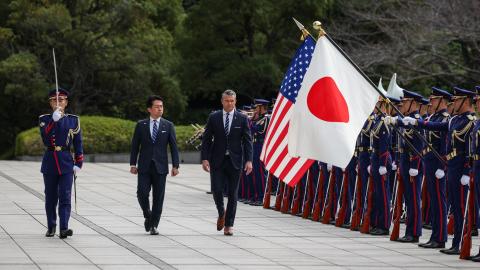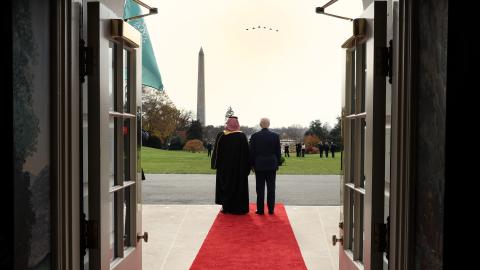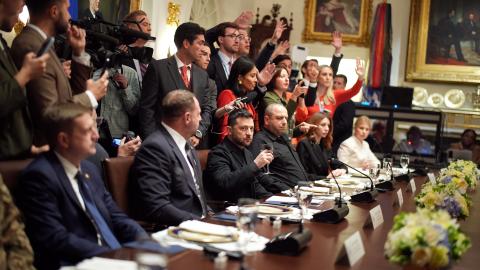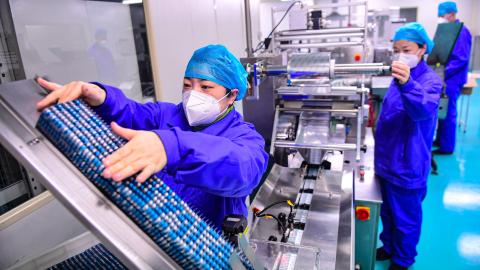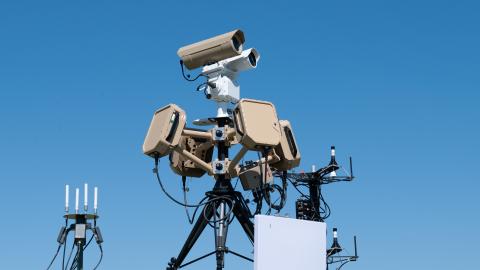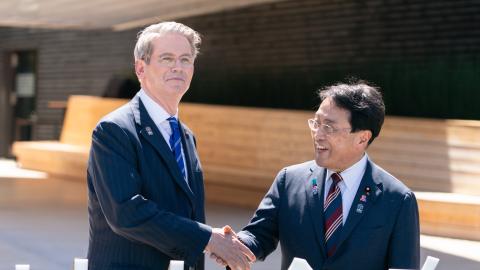After more than three months of formal negotiations and many more months of speculation about the Trump administration’s trade and economic policy toward Japan, Washington and Tokyo have agreed to a trade deal.
Both sides would admit negotiations were a challenge. On April 2, the United States announced a 24 percent tariff on Japan. But after the US announced a 90-day tariff pause on April 9, Treasury Secretary Scott Bessent made Tokyo his top negotiation priority. Japanese Prime Minister Shigeru Ishiba, cognizant of this deal’s economic and political importance, appointed a close political ally, Minister Ryosei Akazawa, to lead negotiations. In eight visits to Washington between April and July, Akazawa met with Bessent, Secretary of Commerce Howard Lutnick, and US Trade Representative (USTR) Jamieson Greer to hammer out a deal. Japan insisted on rolling back the reciprocal, baseline, and sectoral tariffs, while the US sought increased market access and a long-term pathway toward balanced trade.
On July 8, after seven visits by Akazawa, President Donald Trump issued a letter informing Ishiba that the US would set reciprocal tariffs at 25 percent starting August 1. This restricted Ishiba and Akazawa’s negotiating flexibility, leaving a narrow 11-day window between Japan’s July 20 upper house elections and the tariff start date. The prime minister’s Liberal Democratic Party lost its coalition majority in those elections, which cast further doubt that Trump and Ishiba could reach a deal.
But on the evening of July 22, Trump announced on Truth Social that the United States “just completed a massive Deal with Japan, perhaps the largest Deal ever made.” At the White House, he elaborated, “I just signed the largest trade deal in history, I think maybe the largest deal in history, with Japan.”
As details continued to trickle out, it became clear that this was a significant agreement that affirmed each side’s priorities, ensured economic benefits for both sides, and promised to deepen the two countries’ industrial, technological, and energy cooperation. It was also internationally significant. The agreement is Trump’s first deal with a major partner that holds a trade surplus against the United States. With the European Union, South Korea, Taiwan, and the People’s Republic of China still seeking to strike deals with Washington, the US-Japan agreement deserves deeper examination.
Details of the Deal
Several aspects of this innovative deal are worth examining. These are mutually beneficial terms that strengthen the American industrial and technological bases and deepen the US-Japan economic relationship.
$550 Billion in Japanese Investment
The most prominent element of the trade agreement is the $550 billion investment fund that Japan will use to help “rebuild and expand core American industries.” Though the specifics and timeframe of the fund remain scarce, Lutnick stated that he came up with the mechanism in January. The fund will use a combination of equity, credit guarantees, and funding from Japanese public finance institutions such as Nippon Export and Investment Insurance (NEXI) and Japan Bank for International Cooperation (JBIC). It will direct these resources toward the Trump administration’s core industrial priority sectors, such as energy, semiconductors, critical minerals, pharmaceuticals, and shipbuilding. Lutnick has stated that this money will not necessarily go to Japanese firms. But Tokyo has discussed economic security cooperation and foreign direct investment (FDI) programs during these negotiations, which suggests that Japanese companies are willing to participate in such projects.
The $550 billion investment fund is important for Japan’s FDI commitment to the United States in two other ways. First, Japan is already the top foreign investor in the US, with its FDI position reaching $783.3 billion in 2023 and $860.6 billion in 2024. The additional $550 billion will lift Japan further above all other American economic partners and cement bilateral economic ties. On top of this, Japanese firms have already pledged significant investments in key US industries this year: $100 billion in artificial intelligence, $26 billion in steel, and $4.4 billion in automobiles.
Second, the investment fund is important to Japanese FDI because of its potential impact on tariff rate negotiations. Japanese industry representatives have indicated that during tariff talks US officials and members of Congress proposed lowering duties in exchange for increased FDI in America. Tariff proceeds would be much more productive if invested in American industry. According to these officials, such arguments have resonated with many in Congress. This would also align with the White House’s economic and industrial priorities.
Another significant wrinkle of this investment fund is the stipulation that 90 percent of its profits will be reinvested in the United States. Most policy officials in Trump’s orbit welcome FDI. But Robert Lighthizer, the USTR in the first Trump administration, is skeptical of foreign ownership of US assets because non-US firms transfer profits out of America and back to their home countries. Though China is Lighthizer’s primary concern, the stipulation that most of the profits from the $550 billion investment fund will be reinvested in the United States and not repatriated back to Japan may reassure his allies—namely current USTR Jamieson Greer, Lighthizer’s former chief of staff.
Reduction of Tariff Rates
For Japan, tariff reductions are the most important results of the trade deal. First, the US reduced reciprocal tariffs on Japan from 25 percent to 15 percent, a significant cut given that Japan exported $148.2 billion of goods to the United States in 2024. Still, this is higher than the White House’s 10 percent baseline tariff rate (which administration officials have identified as a red line in any tariff talks). Stephen Miran, chairman of the Council of Economic Advisors, justified this rate as a corollary for America’s provision of global military and financial security.
A second important result for Japan is the reduction of US tariffs on Japanese automobiles. These duties, which fall under Section 232 of the Trade Expansion Act of 1962, target industrial sectors that the White House deems central to national security. This was an urgent priority for Tokyo. The auto industry accounts for 2.9 percent of Japan’s gross domestic product (up to 10 percent according to the Japan Automobile Manufacturers Association), $43 billion in exports to the United States, and 8.3 percent of the country’s workforce. Reducing the Section 232 automotive tariffs was especially important for Japanese automakers that depend heavily on exports. For example, 52.4 percent of the cars Mazda sells in the US are made in Japan and would be subject to tariffs. For Subaru, this figure is 44.4 percent. A stable automotive tariff rate is essential for Japanese auto firms’ strategic planning given that automotive product development cycles last 7 to 10 years.
Third, Akazawa and his team were able to secure a safety clause on forthcoming Section 232 sectoral tariffs. The safety clause, akin to a most favored nation trade status, ensures that Japan will pay the lowest possible sectoral tariff rate, even if another nation negotiates a lower rate with the United States. The safety clause will not apply to the 50 percent Section 232 tariffs on steel and aluminum. But it will apply to incipient semiconductor and pharmaceutical tariffs. While it is unclear if the clause will extend to future Section 232 tariffs, this guarantee puts to rest Japanese negotiators’ fear that other nations will strike better deals with Washington.
Market Access and Purchases
The US-Japan trade agreement also includes increased market access, quotas, and purchase agreements that benefit both countries.
Along with the 10 percent baseline tariff, the Trump administration prioritized giving American goods greater access to the Japanese market. The administration believes this is the best pathway to sustainable, balanced bilateral trade. Japan also agreed to waive additional regulatory burdens on cars that have gone through American safety certification.
The deal will also enhance American agricultural firms’ access to the Japanese market. Japan will increase its imports of American rice by 75 percent from 346,000 tons in 2024. Importantly for Ishiba and the LDP, which relies on the farm vote, Japan will merely grant the United States a larger share of its 770,000-ton minimum access rice quota rather than increasing or eliminating the quota. Japan will also retain its $2.36 (¥341) per kilogram tariff on imported rice beyond the minimum access level, which will please Japanese farmers.
Tokyo also committed to purchase $8 billion of American agricultural goods and 100 Boeing aircraft and increase its expenditures from $14 billion to $17 billion.
But Japan’s most significant potential purchase is Alaskan liquefied natural gas (LNG). The proposed $44 billion project would pipe natural gas from Alaska’s North Slope to southern Alaska, where it would be liquefied and shipped to customers in the Pacific. This has been a major priority for Trump. The Alaskan LNG project would give Japan and other Indo-Pacific nations a much-needed energy source while supporting America’s security presence in the Pacific amid rising tensions.
Despite its security and economic merits, there has been minimal enthusiasm for the Alaskan LNG deal so far. Japan needs a new, more reliable LNG supplier. Nine percent of its LNG comes from the Russian Sakhalin-2 pipeline, with contracts ending from 2026–33. But Japanese firms have so far been reluctant to invest in the Alaskan LNG project, preferring instead to buy from and invest in projects based in the Gulf of America. Ishiba, whose office is overseeing the agreement, has yet to make any significant moves.
The new trade agreement may break this deadlock. It states that “the US and Japan are exploring a new offtake agreement for Alaskan liquefied natural gas.” This does not quite square with Trump’s announcement on July 22 that Japan is “forming a joint venture with us in Alaska for the LNG,” and that “they’re all set to make that deal now.” Regardless, it appears that both governments are now seriously discussing the Alaskan LNG project and will need to work closely with the private sector to get the project online in 2030.
Implications and Significance
Because of the deal’s size and scope, it has significant domestic, bilateral, and international implications.
Domestic Politics
The bilateral trade deal adds yet another element of uncertainty concerning the country’s domestic politics. After Ishiba’s LDP lost the Diet upper house majority on July 20, the prime minister faced calls to resign. Still, he vowed to stay in office to conduct tariff negotiations with the United States, which he claimed constituted a “national crisis.” It seems that striking a successful deal should strengthen Ishiba’s position. But many within the LDP continue to call for his resignation. Takayuki Kobayashi, a former minister who ran against Ishiba to lead the LDP last September, demanded that the prime minister resign and take responsibility for the defeat. Meanwhile, Shijiro Koizumi, the current agricultural minister who also ran in last year’s leadership election, approved his Kanagawa prefectural chapter’s submission of a letter requesting party leaders’ resignation. Reports have surfaced that Ishiba will resign his post at the end of August, though the prime minister has denied this.
Observers speculate that a new leader in September may change the terms of the trade deal. In recent days, opposition lawmakers from the Constitutional Democratic Party and the Democratic Party for the People have questioned the $550 billion investment fund and how it would be administered. But Tokyo’s commitment to the deal should not be a major concern given Japan’s limited flexibility and the consensus among other Japanese parties on the agreement’s importance.
Bilateral Relations
The deal will also shape other aspects of US-Japan relations like Japanese defense spending and currency rates.
In a sense, Washington and Tokyo have already begun discussing increased Japanese defense spending. In 2022, Japan responded to greater global insecurity stemming from Russia’s invasion of Ukraine and China’s regional aggression by announcing plans to increase its defense budget to 2 percent of GDP by 2027. During the 2024 presidential campaign, Trump complained about American allies’ freeloading. Japanese government officials feared Trump would demand further Japanese defense spending increases. The Trump-Ishiba summit in February 2025 allayed those fears, as the joint statement referenced Japan’s efforts “to fundamentally reinforce its defense capabilities beyond 2027.” Notably, this statement does not specify a percentage target.
Recent events have reignited Japanese officials’ fears that the US government, especially the Department of Defense, will demand that Japan commit to a significant defense spending increase. At his confirmation hearing in March 2025, Undersecretary of Defense for Policy Elbridge Colby stated that he believed Japan “should be spending at least 3 percent of GDP on defense as soon as possible.” In June 2025, Japan canceled the long-delayed US-Japan security 2+2 meeting between the two nations’ diplomatic and defense chiefs to avoid public controversy after Colby demanded that Japan increase its defense spending to 3.5 percent of GDP. Shortly thereafter at the 2025 North Atlantic Treaty Organization summit, the White House successfully compelled European allies to increase their defense- and security-related spending to 5 percent of GDP. Yet at the July meeting of the Quad (which includes the US, Japan, India, and Australia), Secretary of State Marco Rubio only said that he wished Japan would continue to strengthen its defense capabilities. He also did not quantify a defense spending target. With the conclusion of a trade deal that largely avoided defense issues, it is likely that future discussions will address Japan’s defense spending.
Currency rates between the two countries are another potential issue, as they have been a sore spot for Trump in the past. In March, the president grouped Japan with China as a currency manipulator as a justification for tariffs. This prompted Ishiba to state in the Diet that Japan was not intentionally pushing down the yen’s value to increase exports. At the Group of 7 finance ministers’ meeting in May 2025, Bessent and Japanese Finance Minister Katsunobu Kato “reaffirmed their shared belief that exchange should be market determined and that, at present, the dollar-yen exchange rate reflects fundamentals.”
In the past five years, the Japanese yen has weakened from ¥103 to the dollar in January 2021 to a low of ¥160 in July 2024, before settling into the ¥146 range in recent months. Ishiba’s insistence that Japan does not intentionally devalue the yen is credible. Doing so hurts the government’s defense spending plans and drives up the cost of living for Japanese citizens, creating political difficulties for the LDP. During trade negotiations, Minister Akazawa largely avoided discussions on currency rates. With the conclusion of the deal, these discussions may return. Still, recent developments suggest otherwise.
International Impact
The new US-Japan trade deal also has implications for each nation’s broader international engagement.
First, the trade agreement raises questions about the future of the United States–Mexico–Canada Agreement (USMCA), which is up for renegotiation or renewal in 2026. Amid tariff negotiations, Trump administration officials have said little about USMCA other than that they intend to renegotiate it. But the administration has been aggressive in its negotiations with Mexico and Canada, placing a 25 percent tariff on both countries and demanding that they do more to combat fentanyl trafficking. That translates to a 25 percent tariff on Canadian and Mexican goods that are not compliant with USMCA rules of origin. USMCA-compliant automobiles and auto parts from Canada and Mexico are subject to a 25 percent tariff. Noncompliant goods are assessed a rate of 52.5 percent.
Those figures become significant in the context of the new US-Japan trade deal. Automotive imports from Japan have a lower tariff rate (15 percent) than automotive goods from Canada or Mexico (25 percent). This affects American automakers, such as General Motors, Ford, and Stellantis, that depend on Canada and Mexico for their automotive supply chains and assembly lines. But it also harms Japanese automakers. Honda, Nissan, and Toyota also depend on Canada and Mexico for their products. Moreover, US firms fear that the 50 percent Section 232 tariffs on steel and aluminum will further increase their domestic production costs while Japanese auto companies pay a lower rate on their imports. The American Automotive Policy Council, which consists of GM, Ford, and Stellantis, criticized the trade deal as harmful to North American–built vehicles. The administration’s handling of these concerns may indicate how it will approach USMCA renegotiations in 2026.
The US-Japan trade deal also provides a model for US deals with the EU and South Korea. Like Japan, these entities are major US trading partners with significant trade surpluses. Reports indicate that Brussels is on track to agree to 15 percent reciprocal tariffs and automotive tariffs. South Korean government and industry officials are also aiming to secure a 15 percent tariff in exchange for a similar industrial investment fund and increased market access for US corn products. Given the number of states hoping to lock down deals before the White House’s August 1 deadline, the US could benefit from having the EU and South Korea follow the Japanese template.
Recent American trade agreements with Japan and other countries such as Indonesia, Vietnam, and the Philippines strengthen Washington’s position ahead of the Stockholm talks on July 28 and 29. China had been using trade to drive a wedge between the United States and Indo-Pacific nations. But these agreements strengthen US economic ties with key allies and partners in the region. They also give Washington leverage in talks with Beijing to extend the London trade agreement. This is especially important in the face of aggressive Chinese policies, which include using rare earth export restrictions for technology theft, preventing American citizens in China from returning home, and sponsoring cybersecurity breaches against American software infrastructure.
Conclusion
As the August 1 tariff deadline approaches, Japan has achieved a significant win by securing a deal. Despite Japan’s three-month negotiation deadlock, Tokyo has successfully delineated the key elements of an agreement that ensures mutual benefits:
- Using innovative financial instruments to invest in critical industrial sectors
- Removing market barriers to level the playing field
- Agreeing to strengthen bilateral commercial and energy engagement
In turn, these initiatives have implications on defense spending, currency rebalancing, the USMCA’s future, and other issues.
Importantly, this agreement creates a framework to strengthen American industrial resiliency and deepen US-Japan economic and technological cooperation. With America’s strategic competitors more willing than ever to use all the means in their diplomatic, economic, and technological toolboxes to threaten global prosperity and security, Washington needs effective economic partnerships more than ever.
